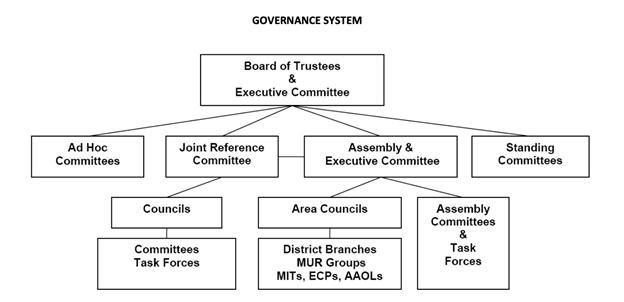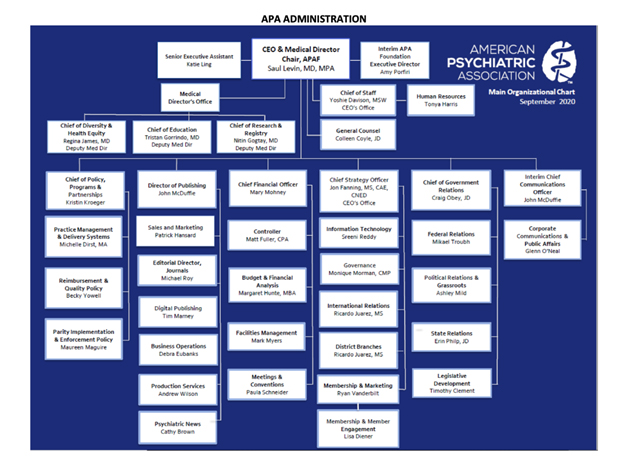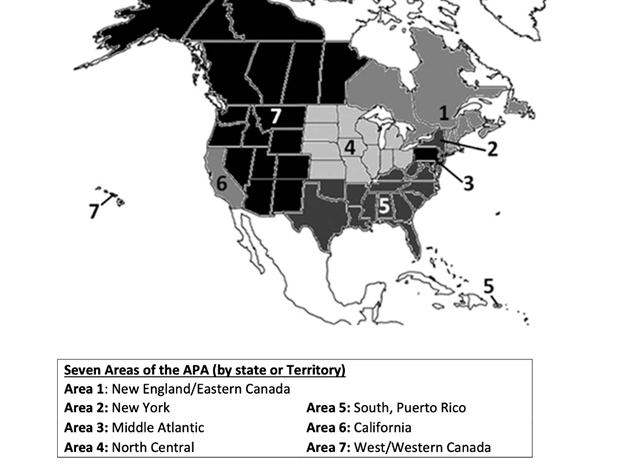Mon, 03/08/2021 - 15:10
What does the acronym ACROSS stand for, and what was the driving force behind this initiative?
Michelle Cochran, MD
Interview by Alex Ghobadi M.D.
I am CTMSS's representative to APA, and APA Assembly Allied Organization Liasion (AAOL), who has a membership on the ACROSS committee of the APA Assembly. ACROSS is an acronym for Assembly Committee of Representatives of Subspecialties and Sections.
The APA Assembly is a deliberative body that recommends action to the Board of Trustees (BOT). The Assembly serves the needs of the District Branches. It can discuss matters brought by members, chapters, district branches, Area councils, task forces, or committees. The Assembly can make policy for the Board. When the Clinical TMS Society became an affiliate group of the APA, the organization was allowed to elect one ACROSS representative to the APA Assembly. As an assembly member, I must attend my Area meeting (scheduled virtually this year, for two days in March, approximately 3 hours each day) and the APA Assembly meetings at the Annual APA meeting and the Fall IPS meeting (to be held virtually this year). Assembly meetings are open to the membership of the APA, so you can attend if you like.
The APA is a large organization with a complex governance system. Fortunately, it has an over 250-page Operations Manual, which helped me get oriented to the organization I have been a member of for over 25 years.
At the top are the Board of Trustees and the Executive Committee. Then the Ad Hoc Committees, Joint Reference Committee (JRC), Assembly & Executive Committee, and Standing Committees. The JRC is composed of Councils and Committees, and Task Forces. The Assembly is composed of Area Councils, District Branches, Minority Under-Represented (MUR) groups, Members in Training (MIT), Early Career Psychiatrists (ECP)s, Assembly Allied Organization Liaisons (AAOL), and Committees and Assembly Task Forces. The APA also has an Administrative Staff as well. (See the organizational charts below)



What do you hope to accomplish as the APA ACROSS Representative?
My position is a 3-year term, and my long-term goal is to work on CTMSS's mission within the APA.
CTMSS is an international professional association dedicated to:
** optimizing clinical practice,
** improving awareness of TMS
** and increasing the accessibility of TMS
It is well known that the representation of TMS lectures and other neuromodulation is low at the APA. So, to accomplish the CTMSS mission, my long-term goal is to create a Council on Neuromodulation within the APA.
The APA currently has 13 councils. Hopefully, they will have 14 at the end of my 3-year term (or before).
The first step in this process is to develop a Caucus on Neuromodulation. I have obtained more than the required 50 signatures by APA members to start a Caucus, and these have been given to the Joint Reference Committee of the APA.
What benefits can CTMSS members expect as a result of this initiative?
My hope is that by wrapping all neuromodulation together and enlisting the APA in the mission of CTMSS, that more can be accomplished.
What barriers do you anticipate facing as the APA ACROSS Representative?
I am new to the governance of the APA, and learning the ropes is part of the process. I have jumped in and have already written two ACTION Papers for the Assembly.
What objectives/goals would having an APA Caucus on Neuromodulation have?
The Caucus on Neuromodulation would bring "all the players" to the table within the APA's governance. By enlisting our ECT, VNS, DBS, TNS, tACS, tDCS colleagues, we can increase awareness of these treatments and advance the education at the APA meetings. To start a caucus, fifty (50) APA members must indicate their interest in writing; I have more signatures than this, 75 APA members would have to register for the listserv within the first two years. The APA will establish a listserv for use by the Caucus.
The Charge
The Caucus of Neuromodulation (and eventually the Council) would be charged with the following:
(1) Liaison with the Affiliated Neuromodulation Societies to address mutual interests and priorities and advance shared goals
(2) Providing psychiatric leadership in the growing field of neuromodulation of psychiatric brain disorders
(3) Developing and clarifying the role of the psychiatrist and other clinicians in neuromodulation;
(4) Formulating policy recommendations related to prevention, education, treatment, and research in neuromodulation treatments for psychiatry;
(5) Considering important developments in basic knowledge, treatment, methodology, treatment systems, and related matters in the field of neuromodulation, and dissemination of that knowledge;
(6) In cooperation with other appropriate APA components, enhancing the quality and quantity of medical education in neuromodulation treatment, at all educational levels, including undergraduate, residency, fellowship, and continuing medical education;
(7) Providing additional liaison to medical, educational, consumer interest, and governmental organizations Interested in neuromodulation treatments;
(8) Collaborating with other councils and components of the APA on common issues related to the role of psychiatry in neuromodulation treatment; for example, to improve the quality of care and risk management for neuromodulation disorders, to foster adequate research efforts and funding, and to foster adequate reimbursement for treatment.
Scope of work product:
(1) It is expected that from year to year, the Council will continue the work of its predecessor council and expand on it. It will maintain active communication with Neuromodulation Societies;
(2) provide ongoing consultation to initiatives to train and provide clinical mentorship to physicians who use neuromodulation treatments in their offices and other settings,
(3) maintain ongoing collaboration with components focused on other psychiatric subspecialties and seek opportunities to join together in efforts to strengthen the respective fields; (5) work closely and collaboratively with the American Academy of Addiction Psychiatry.
For APA members, what benefits would you tell them about that is worthy of joining CTMSS?
The CTMSS is the premier organization for TMS prescribers that offers education, advocation, and network connections.
What about CTMSS members who aren't currently an APA member? What benefits should they expect from having and/or maintaining an APA membership?
The APA's mission is:
(1) to promote the common interests of members,
(2) to improve treatment and care of individuals with mental illness,
(3) to advance the standards of all psychiatric services
(4) to promote research, professional education,
(5) to foster cooperation of all who are concerned with the medical, psychological, social and legal aspects of mental health, and illness
(6) to make psychiatric knowledge available to practitioners of medicine, science, and the public
(7) to promote the best interests of patients
(8) and to advocate for its members.
I would like to see the APA held accountable for doing these things for their members (all members, particularly CTMSS / APA members).